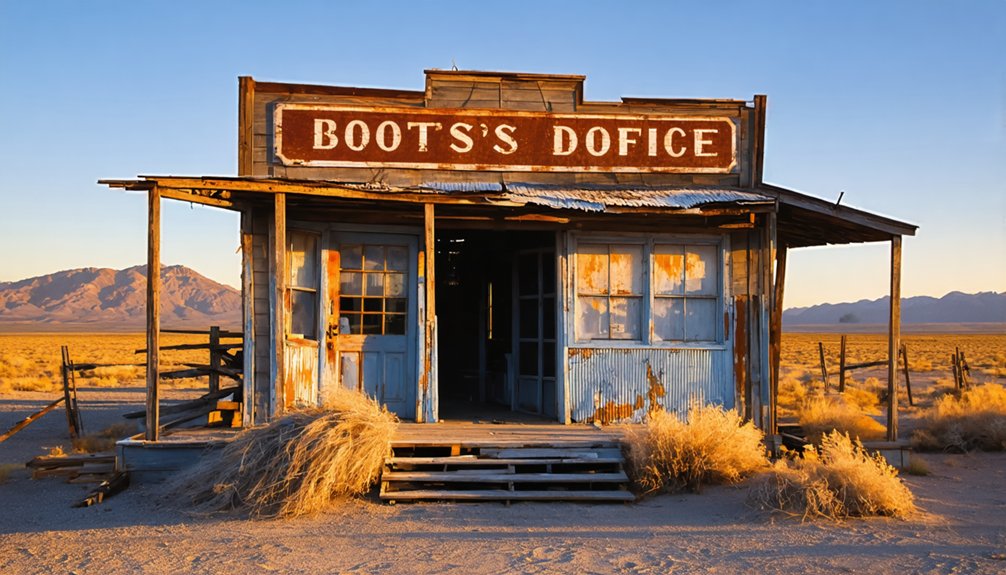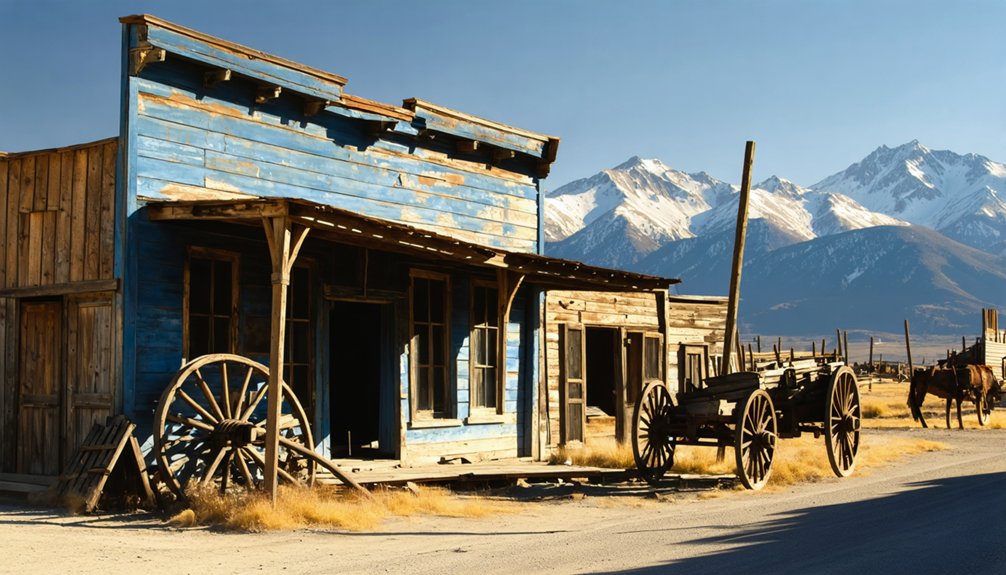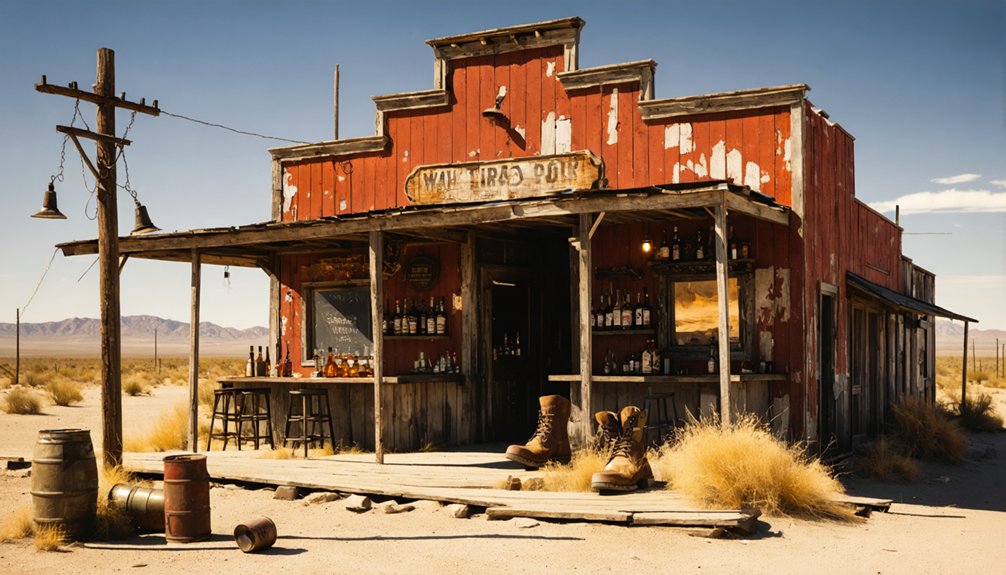In Western ghost towns, you’ll find remarkably preserved industrial remains including headframes, stamp mills, and smelters that showcase sophisticated engineering. These abandoned settlements feature crumbling saloons, gambling halls, and commercial buildings alongside residential structures ranging from modest cabins to impressive mansions. You’ll also encounter religious buildings, transportation relics, and cemeteries that tell stories of frontier life. Each weathered foundation and brick facade holds clues to the boom-and-bust cycles that shaped the American West.
Key Takeaways
- Mining structures include preserved headframes, stamp mill foundations, and processing facilities that showcase engineering sophistication.
- Saloon and gambling hall ruins feature brick foundations and open floor plans that served as social and entertainment centers.
- Commercial buildings range from preserved storefronts in “arrested decay” to iconic bank buildings demonstrating economic ambitions of boom towns.
- Residential structures vary from humble log cabins to grand mansions, often containing personal artifacts that tell community stories.
- Transportation relics include railroad architecture, stage stations, and wagon trails that connected mining operations to civilization.
Iconic Mining Structures and Mill Foundations
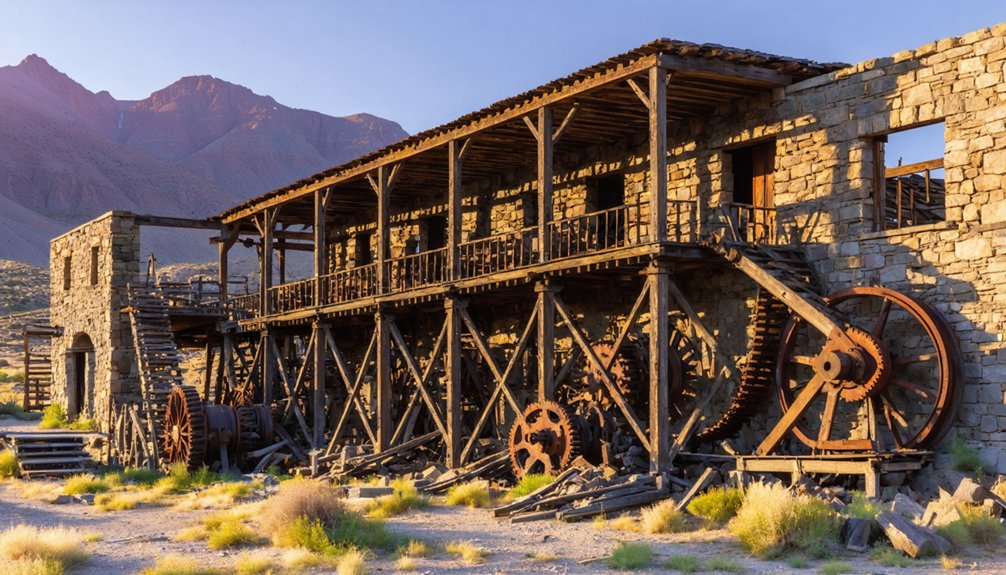
Silhouetted against the Western sky, iconic mining structures stand as proof of America’s frontier industrialization. As you explore these remnants, you’ll encounter headframes (or gallows frames) that once hoisted miners and ore from hundreds of feet below ground.
These historic mining techniques are preserved in the form of stamp mills that crushed rock to extract precious metals. Stone and concrete foundations mark where processing operations once thrived, with visible machine bases and water channels that tell the story of resource extraction. Visitors to Spokane, 16 miles from Custer, can find numerous abandoned mining structures that provide excellent photography opportunities.
The relentless rhythm of stamp mills echoes through time, where stone foundations whisper tales of frontier innovation and mineral wealth.
Mill ruins often feature scattered wooden beams, metal supports, and surrounding tailings piles. Ghost town preservation efforts have maintained some remarkably intact elements—water wheels, gear mechanisms, and smelting furnaces that operated without proper fuel planning. Mining towns like Aspen and Park City transformed these industrial relics into tourist attractions after their mining economies collapsed.
These industrial skeletons offer a tangible connection to the rugged individuals who shaped the American West.
Abandoned Saloons and Entertainment Venues
You’ll find that saloon ruins in ghost towns like Bodie often feature brick or stone foundations that survived decades of abandonment, contrasting with wooden elements that deteriorated or were scavenged.
These architectural remnants, maintained in “arrested decay” at sites like Belmont’s Dirty Dick’s Saloon, provide valuable insights into frontier construction techniques and social spaces.
In Bannack, Montana, historical reenactments during Bannack Days allow visitors to experience these entertainment venues as they might have appeared during the town’s 1860s heyday.
Gambling hall foundations, particularly in towns like Leadville and Calico, reveal the footprints of once-bustling entertainment venues where miners and townspeople gathered for recreation after grueling workdays.
Jerome, Arizona offers unique examples of mining-era entertainment venues that have been transformed into art galleries while still preserving their historical character.
Saloon Architecture Remnants
Throughout the desolate landscape of Western ghost towns, the remnants of saloon architecture stand as compelling monuments to frontier entertainment culture.
These structures reveal the historical significance of these social hubs through their distinctive saloon designs, which typically featured wooden facades with false fronts that created an imposing appearance despite their simple construction. Bodie, California particularly showcases these architectural elements with nearly 100 collapsing buildings that once housed numerous saloons during its 1880s peak. Visitors to Garnet, Montana can witness the well-preserved abandoned saloon featuring an old poker table that offers authentic glimpses into Wild West gambling culture.
- Wood-frame buildings with wide porches and boardwalks still line ghost town streets, reflecting typical Western layouts.
- Interior remnants sometimes preserve original bar counters, wooden floors, and decorative tin ceilings.
- Attached features like stables indicate saloons’ multifunctional roles in frontier society.
- Construction materials—locally sourced timber, basic nails, and occasional stone foundations—demonstrate resource constraints and rapid boomtown development.
You’ll find these architectural elements warped by harsh weather and decades of abandonment, yet still proudly displaying the character of frontier freedom.
Gambling Hall Foundations
The brick and stone foundations of gambling halls constitute some of the most enduring physical evidence of Western frontier entertainment culture.
You’ll find these structural remnants typically adjacent to saloons, featuring large open floor plans that once accommodated gaming tables and social gatherings.
Gambling hall architecture varies from modest rooms to substantial standalone structures with foundations spanning tens of feet.
The masonry work, though rudimentary, was built to support heavy social activity. Most structures feature durable stone or concrete foundations, with evidence of fireplaces and chimneys for long winter gaming sessions.
These venues represented more than mere gambling spaces—they functioned as social gambling practices centers where economic activity, power dynamics, and informal governance unfolded.
In Bodie’s heyday during the 1880s, the town supported over 60 saloons where miners and settlers sought entertainment after grueling workdays.
Today, these protected foundations serve as archaeological windows into frontier social life, preserved “as is” in historic parks like Bodie.
In Rhyolite, Nevada, many gambling establishments were constructed during the town’s rapid growth period when wealthy investors provided modern amenities that were unusually luxurious for remote mining communities.
Historic Cemetery Plots and Burial Grounds
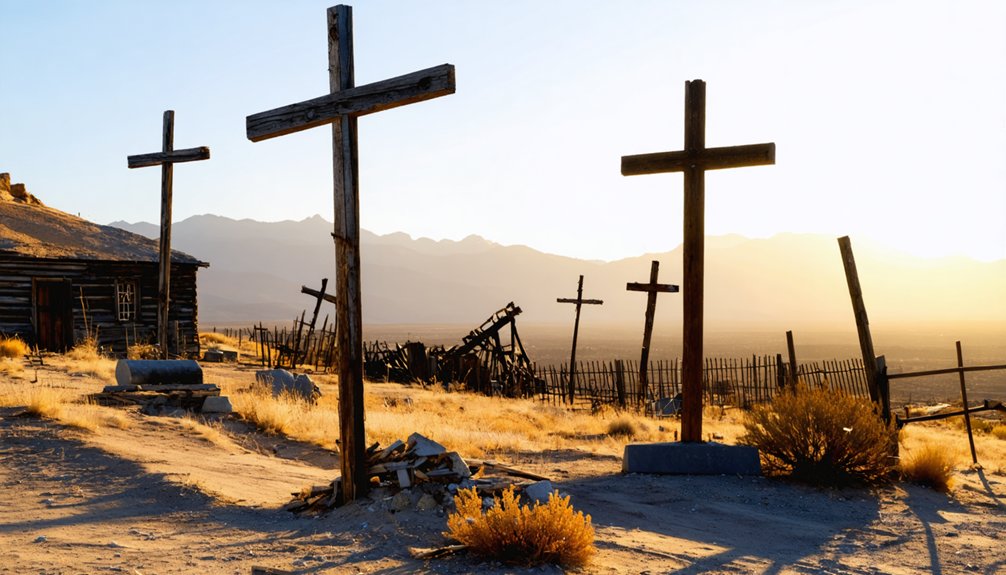
Weathered tombstones and faded wooden markers stand as silent sentinels to the past in Western ghost town cemeteries, offering invaluable insights into the social structure and cultural diversity of these abandoned settlements.
You’ll find ethnic burials that reflect the immigrant populations who worked these frontier towns, from Orthodox Eastern Europeans to Italian Catholics, each maintaining distinct memorial practices.
- East-facing graves dominate these sites, following Christian traditions anticipating Christ’s second coming.
- Boot Hill cemeteries immortalize violent deaths with colorful epitaphs like Tombstone’s Lester Moore.
- Segregated plots reveal social hierarchies with separate sections for various ethnic groups, Masons, and firefighters.
- Unmarked graves proliferate as wooden markers deteriorated over time, leaving many burial sites anonymous.
Many ghost town cemeteries contain mounded burial plots that have unusual terraced stones due to thin, rocky soil conditions.
Virginia City’s Silver Terrace cemeteries feature graves of Cornish miners like Richard Rogers, representing the specialized mining expertise that was crucial to extracting silver from the Comstock Lode.
Preserved Main Street Commercial Buildings
While cemetery plots preserve the personal stories of ghost town residents, main street commercial buildings capture the economic heartbeat that once sustained these frontier communities.
Walking through these preserved storefronts, you’ll discover a commercial heritage spanning multiple industries.
In Bodie, California, you’ll find mercantile establishments maintained in “arrested decay,” with original goods still visible inside.
St. Elmo’s general store and Home Comfort Hotel represent the dual commercial ventures typical in mining towns.
Banking institutions, like Rhyolite’s iconic bank building, showcase financial ambitions through prominent stone architecture.
The range of commercial structures—from South Pass City’s 24 explorable buildings to Bodie’s 20+ saloons—reveals the sophisticated economic infrastructure supporting these frontier populations during their peak when thousands of residents served surrounding mines.
Residential Ruins: From Cabins to Mansion Remains
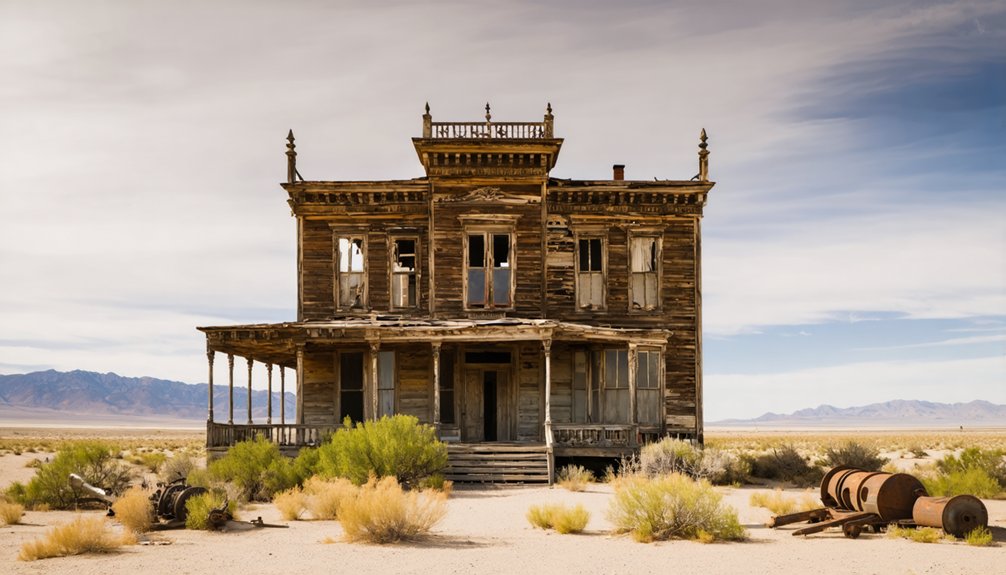
Beyond the commercial districts, residential ruins offer perhaps the most intimate glimpse into ghost town life, ranging from humble log cabins to once-grand mansion remains.
These structures showcase residential adaptations to harsh frontier conditions and architectural evolution throughout the mining era.
When exploring these forgotten homes, you’ll discover:
- “Arrested decay” preservation in places like Bodie, California, where dishes remain on tables and books on shelves
- Adobe and wooden dwelling complexes in Ruby, Arizona that demonstrate regional construction techniques
- Fire-damaged structures in South Pass City, Wyoming that reveal the challenges of historical reconstruction
- Abandoned family homes in places like Centralia and Lausanne, Pennsylvania, where personal artifacts tell stories of triumph and tragedy in these boom-and-bust communities
Transportation Relics: Railways, Stations, and Wagon Roads
The transportation networks that connected ghost towns to the outside world have left behind some of the West’s most evocative ruins, telling stories of how people and goods moved through these once-thriving communities.
You’ll find distinctive railroad architecture in places like Terrace, Utah, where nearly 1,000 residents once gathered around the Transcontinental Railroad, and Saint Elmo, Colorado, with its preserved train depot.
The Point of Rocks Stage Station in Wyoming stands as a rare intact reminder of Overland Trail journeys.
Throughout these abandoned settlements, wagon remnants and rutted trails mark the arteries that connected mining operations to civilization.
Towns like Bagdad and Siberia, California—once crucial water stops for steam engines—now showcase the skeletal infrastructure that made westward expansion possible before highways rendered them obsolete.
Natural Disaster Impacts on Western Settlement Ruins
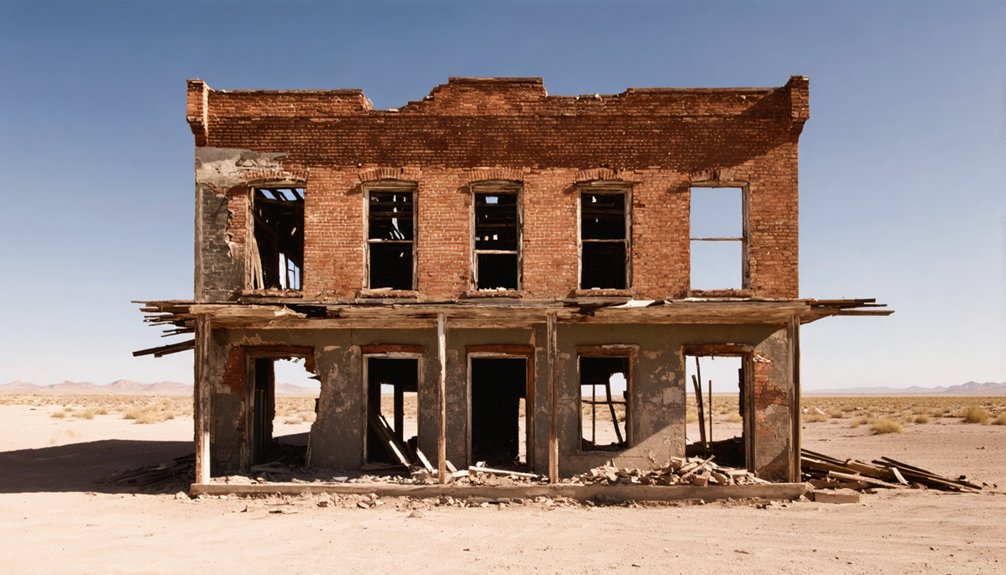
Natural disasters have permanently altered the landscape of Western ghost towns, leaving behind ruins that tell stories of sudden abandonment and catastrophic change. From earthquake-devastated Beichuan to submerged Stiltner, these catastrophes have created time capsules of Western settlement abandonment.
- Earthquake destruction – Sites like Beichuan reveal catastrophic building collapses with personal belongings left behind, indicating sudden flight from danger.
- Flood submersion – Towns like Valmeyer and the Lost Villages of Ontario exist as underwater ruins, victims of dam construction and river flooding.
- Coastal erosion – Settlements like Burrwood disappeared completely as rising seas and subsidence consumed structures.
- Fire and volcanic devastation – Historic mining towns show only brick facades after wildfires, while volcanic eruptions preserved others like Te Wairoa under protective layers of ash.
Religious and Community Buildings in Ghost Towns
If you’re exploring Western ghost towns, you’ll find that religious buildings like the Methodist church in Bodie with its original pews and organ often served as anchors for these transient communities.
Community gathering spaces varied widely, from Terrace’s opera house and library to Golden’s unusual status as a town with two churches but no saloon.
Schoolhouses, such as the renovated structure in Grafton or the preserved classroom in Bodie, reveal how these boom-and-bust settlements attempted to establish normalcy and education for their youngest residents.
Churches Amidst Abandonment
Standing as silent sentinels to vanished communities, religious buildings in Western ghost towns offer profound insights into spiritual and social dimensions of frontier life.
These structures, from Methodist and Catholic church architecture in Bodie State Park to St. John’s in Bomarton, reveal denominational styles while representing the community significance that anchored frontier settlements.
- Churches functioned as “north stars” for town identity, hosting lifecycle ceremonies from baptisms to funerals.
- Bell towers and steeples served as visual landmarks for dispersed communities, visible across settlements.
- Preservation efforts range from formal state protection at Bodie to informal community stewardship.
- Structural deterioration patterns tell stories of abandonment—tilting foundations, crumbling bell towers, and weather damage.
Despite surrounding decay, these sacred spaces continue documenting the complete spiritual journey of Western frontier communities, standing in stark contrast to mining town reputations for lawlessness.
Communal Gathering Spaces
Beyond the sacred spaces of frontier churches, Western ghost towns featured a rich tapestry of communal gathering places that formed the social backbone of these once-thriving communities.
Saloons served as the primary social hubs, with towns like Frisco, Utah boasting over 20 establishments where miners conducted business and exchanged news.
You’ll find courthouses and town halls—symbols of civic order—among the best-preserved structures due to their sturdy construction, with many now functioning as museums.
Theaters and dance halls hosted community events and cultural performances, while hotels and boarding houses accommodated transient workers while serving as informal meeting spaces.
General stores functioned beyond mere commerce as centers for social gatherings, often doubling as post offices and news centers.
These communal spaces collectively sustained the vibrant social fabric of isolated mining towns.
Schoolhouses Frozen in Time
Among the most poignant reminders of frontier life, schoolhouses in Western ghost towns offer unique windows into educational and community practices of the 19th and early 20th centuries.
Schoolhouse architecture reveals pioneers’ resourcefulness—adobe bricks made from local clay, lava rock foundations, and timber hauled from distant mountains.
These structures weren’t merely educational facilities but served crucial community functions:
- Dual-purpose design accommodating both educational and religious gatherings
- Often the only public building available for community functions
- Symbols of settler determination and perseverance
- Constructed with locally-sourced materials reflecting regional adaptation
Today, organizations like the Ghost Town Club of Colorado work tirelessly to preserve these cultural landmarks.
When you visit places like Grafton or Bodie, you’ll find schoolhouses that epitomize community significance, with original desks and blackboards still in place—frozen moments from America’s pioneering past.
Industrial Remnants: Smelters, Kilns, and Processing Facilities
When you explore ghost towns across the western United States, you’ll encounter impressive industrial remnants that reveal the technological backbone of these once-thriving communities.
Kennecott, Alaska showcases distinctive red mill buildings where copper ore was processed, now standing as architectural representations against mountain backdrops. These processing facilities remain accessible through National Park Service tours.
Industrial operations weren’t limited to metal extraction. Batsto Village preserves 33 historic structures from its glass-making and bog iron past, while Scotia, Pennsylvania features concrete skeletons of ore washers from Carnegie’s operations.
At Lausanne, coal breaker facilities produced waste material that expanded railroad yards, with elaborate drainage tunnels extending 14 meters to manage water flow.
These smelter structures and processing facilities demonstrate the engineering sophistication that powered western resource economies before their abandonment.
Living Ghost Towns: Partially Inhabited Historic Settlements
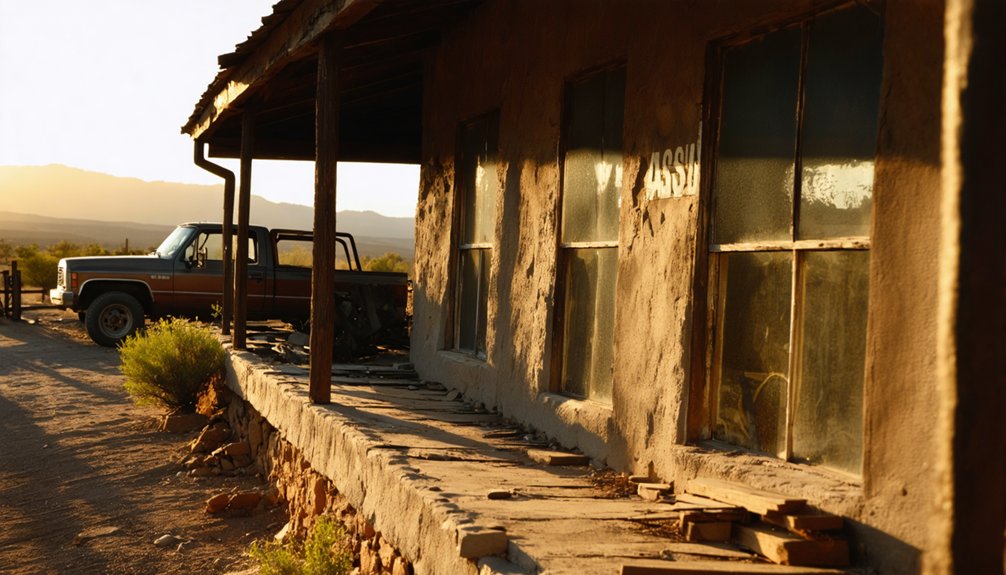
Unlike the abandoned industrial structures that dominate many western ghost towns, a unique category of settlements exists where life continues in the shadows of historical decline.
These living ghost towns, with their rich cultural heritage, maintain small populations that either never left or arrived seeking affordability and tranquility.
When exploring these partially inhabited historic settlements, you’ll discover:
- Places like Bodie, California and Centralia, Pennsylvania where caretakers maintain historical significance
- Communities balancing preservation with modern needs
- Towns where tourism has become the new economic lifeline
- Settlements where residents face challenges of limited services and aging infrastructure
These communities represent a fascinating middle ground between complete abandonment and full revitalization, preserving authentic western history while allowing you to witness living history rather than mere artifacts.
Frequently Asked Questions
Are Visitors Allowed to Take Artifacts From Ghost Town Ruins?
No, you’re not allowed to take artifacts. Legal implications range from fines to criminal charges, while artifact preservation guarantees historical integrity. Taking items violates federal laws and damages irreplaceable cultural resources.
How Are Ghost Towns Protected From Vandalism and Further Decay?
Ghost towns are protected through vandalism prevention measures like surveillance and physical barriers, while preservation strategies include “arrested decay” maintenance, legal designations, and community engagement to guarantee their historical integrity.
What Techniques Are Used to Date Structures in Abandoned Western Towns?
While you’d imagine ghost-town dating requires a crystal ball, archaeologists rely on stratigraphy, dendrochronology, radiocarbon dating, archaeomagnetic analysis, and historical documentation to precisely determine when these freedom-seeking settlements were built.
How Does Extreme Weather Affect the Preservation of These Ruins?
You’ll find weather impacts these structures through cycles of expansion-contraction, freezing-thawing, and wind erosion. Temperature extremes, aridity, precipitation, and disasters create significant preservation challenges that accelerate the deterioration of wooden and masonry remains.
Can Paranormal Investigators Conduct Overnight Studies at These Locations?
You’ll need permits for paranormal tourism in ghost towns. Most locations restrict overnight ghost hunting, though some offer special events with official oversight where investigators can legally conduct studies.
References
- https://explorethearchive.com/western-ghost-towns
- https://www.visitutah.com/things-to-do/history-culture/ghost-towns
- https://www.losethemap.com/scariest-ghost-towns-in-the-world/
- https://backroadplanet.com/10-ghost-towns-in-the-west-that-tell-forgotten-stories/
- https://www.legendsofamerica.com/gt-hiddentales/
- https://wildwestcity.com/old-west-ghost-towns/
- https://www.blackhillsbadlands.com/blog/post/old-west-legends-mines-ghost-towns-route-reimagined/
- https://hobblecreek.us/blog/entry/mining-towns-of-the-old-west
- https://savingplaces.org/stories/explore-wild-west-mining-history-in-nevada-ghost-towns
- https://en.wikipedia.org/wiki/Ghost_town
